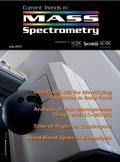Taking Stock of the Mass Spectrometry Marketplace
With May's ASMS Conference now receding in the collective rearview mirror of the industry, the summer is as good a time as any to take stock of the analytical chemistry marketplace. This year's show, held in Salt Lake City, Utah, demonstrated once again the vitality and robustness of the field of mass spectrometry, as innovation and technological advancement were in evidence everywhere you looked.
With May's ASMS Conference now receding in the collective rearview mirror of the industry, the summer is as good a time as any to take stock of the analytical chemistry marketplace. This year's show, held in Salt Lake City, Utah, demonstrated once again the vitality and robustness of the field of mass spectrometry, as innovation and technological advancement were in evidence everywhere you looked. New instrumentation and product introductions were abundant, and if there was any doubt that MS resisted the recession, there can be no doubt that the recovery has begun for this vital segment.

David Walsh
And as always, the Current Trends in Mass Spectrometry series (and on a broader scale, Spectroscopy and LCGC in general) reflects the rapid pace of development in the market. If there is a topic or topics that dominate the technical sessions at a conference such as ASMS, you will surely see it covered in these pages. This month's issue contains research articles on topics such as utilizing UHPLC–MS for identifying pesticides in baby food. This has been a consistently hot topic since the baby formula scare several years ago, but this particular article represents the emergence of LC–MS techniques in this application area, which was formerly dominated by GC–MS and other techniques. Add to this an article targeting the biomedical community on urine analysis with LC–MS-MS and an article examining the use of new MS software for identifying volatile organic compounds in consumer products, and we think you'll see most of the most critical issues currently facing the research community and society as a whole represented in this volume.
Finally, for a recap of mass spectrometry's premier event in the 2010 ASMS Conference, please see article titled "58th ASMS Conference Review" of this issue. Whether you are a chromatographer, a spectroscopist, or do research in another field that utilizes MS techniques and instrumentation, LCGC and Spectroscopy continue to represent two of the analytical chemist's most valuable resources.
Enjoy the issue.

David Walsh
Editor-in-Chief

Regulatory Deadlines and Supply Chain Challenges Take Center Stage in Nitrosamine Discussion
April 10th 2025During an LCGC International peer exchange, Aloka Srinivasan, Mayank Bhanti, and Amber Burch discussed the regulatory deadlines and supply chain challenges that come with nitrosamine analysis.













